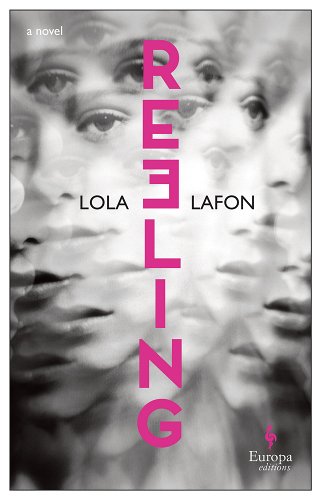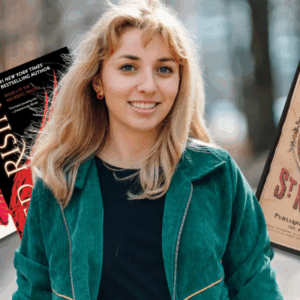She’d lived through so many scene changes, appearances, a life of endless nights and fresh starts. She knew all about reinvention. She knew the backstages of so many theaters, their woody smell, those winding corridors in which dancers jostled, the tired pink walls and faded linoleum of windowless dressing rooms, those mirrors framed with light bulbs, the tables on which a dresser would lay out her costume with, pinned to it, a label: CLÉO.
A cream-colored G-string, a pair of nude tights for under the fishnets, a sequin-and-pearl-covered bra, the elbow-length ivory gloves, and the high-heeled sandals reinforced with coral elastic at the instep.
Cléo would arrive before the others; she liked that time when there wasn’t yet anyone fussing around her. That still silence, barely disturbed by the voices of the technicians checking the stage lighting. She’d take off her street clothes, pull on some sweatpants, and then, sitting topless in front of the mirror, would start the process that would see her disappear.
Half an hour to erase herself: she’d pour Porcelain 0.1 foundation into her cupped hand, soak a latex sponge with it. Its beige tint eliminated the pink of her lips, the flickering mauve of the eyelids, the freckles high on her cheeks, the small veins on the wrists, the scar from her appendicitis surgery, the birthmark on her thigh, a beauty spot on the left breast. For her back and bottom, help was needed from another dancer.
The hair-and-makeup artist would come by at 6 P.M., his belt-bag stuffed with brushes. He’d re-powder the forehead of one, apply concealer to the pimple of another, correct some shaky eyeliner. His calm, minty breath caressed cheeks, the rubbery sound of the gum he always chewed served as a lullaby, and the girls dozed in a hairspray haze. By 7 P.M., Cléo’s nocturnal face was that of all the other dancers: an anonymous woman with false eyelashes, supplied by the establishment, cheeks flushed with fuchsia, eyes fiercely enlarged with black liner, and a pearly shimmer from cheekbone to eyebrow arch.
Cléo had stood behind dozens of red-velvet drapes, curtains, felt hangings; she’d been through this same ritual hundreds of times, these incantatory checks: shaking the head from right to left to test the hold of the hair, jumping in place to keep the thigh muscles warm while awaiting the stage manager’s signal, that 4-3-2-1 countdown. The dressers fastened, tweaked, secured, one last time, the requisite feathered headdress, that deceptive crown of softness, its support gripping the shoulder blades like an iron backpack.
Cléo and the others liked to gauge the audience from behind the curtain, interpreting the slightest sneeze or throat clearing: guess they’re on edge tonight.
Barely out of their coaches—they came from Dijon, Rodez, the airport—they found their seats like overexcited schoolkids, dazzled by the reflections from the crystal glasses on their table and the brass champagne buckets. They marveled at the white rose in its translucent vase, the attentiveness of the waiters, the red banquettes and white tablecloths, the veined marble of the grand staircase. The men smoothed down their trousers, creased from the journey; the women had all visited the hairdresser for the occasion. The tickets safe in their wallets were a birthday gift, a wedding present, purchased long ago for a once-in-a-lifetime splurge. Darkness descended on the auditorium and was greeted by their thrilled whispers: it would sweep away worries, debts, and loneliness. Every evening, when Cléo came on stage, the dusty heat of the projectors took her by surprise, even in the small of her back.
The dancers burst forth, shot through with arching grace, arms open and slightly rounded, they redefined the horizon: a glittering line of identical polished smiles, a set of regimented legs, a swishing and spangled exuberance. As the spectators left the theater, they passed the dancers without recognizing them: pale, tired girls with lacquer-dulled hair.
Cléo had read this: the fascination of babies with the sheen of a porcelain plate came from our ancestral fear of dying of thirst.
Cléo had read this: the invention of the sequin was accidental. It was down to Henry Rushman, an employee of a company in New Jersey that disposed of plastic waste by crushing it. So many years spent putting up with the din of the machines until that day in 1934, when, just as Rushman was about to leave the workshop, he’d noticed in the vat, among the debris, a minuscule gem with a glint of turquoise. Barely lit in the fading daylight, the crusher was sprinkled with silver and gold, like glittering mica. The residue was reflecting the light.
Sequins emerged from what was deemed worthless; theirs was the beauty of uncertainty. Sometimes it was put to Cléo that all this was trashy, just like the diamanté necklaces resting on her solar plexus, those ruby-red rhinestones circling her waist.
It was all fake, and the disturbing beauty of this world depended on that, she would retort. The girls pretended to be naked, they exaggerated their joy on stage for all of ninety minutes and sang “Ça c’est Paris!” when they hailed from Ukraine, Spain, or Clermont-Ferrand. Sweat stained the satin of their bustiers, its yellowish trace lingering despite dry-cleaning; G-strings were doused in antibacterial spray; fishnets dug into the soft part of the thighs, leaving crisscrossing marks. From a distance, no one noticed a thing.
A lighting engineer had taught Cléo that the cheapest panne velvet shimmered under the spotlights, while, conversely, the same lights dulled the sheen of genuine silk. Light conjured away rips, creases, signs of cellulite, scars; it softened wrinkles and the garish red of cheap hair dye. Bustiers made of sequined fabric left scarlet blotches on Cléo’s sides, claret nicks under her armpits: bits of plastic sharpened by sweat. From a distance, no one noticed a thing.
__________________________________
From Reeling by Lola Lafon, translated by Hildegarde Serle. Reprinted by permission of Europa Editions. Copyright © 2022.













